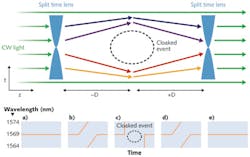NONLINEAR OPTICS: Time cloak hides optical 'event'
“Temporal cloaking,” a time analogue of invisibility cloaking, has been demonstrated optically by scientists at Cornell University (Ithaca, NY).1 While an invisibility cloak hides an object in space, a temporal cloak hides an event in time. This can be made to happen within a spectrally dispersive material that time-compresses portions of a phase-modified continuous light beam. A section of material with the opposite dispersion then restores the beam to its gapless form. If an event occurs in the temporal gap, it does not affect the beam and is thus not seen.
The concept can be better understood by thinking of it in terms of a conventional 2D representation of an optical system, but with one change: The spatial axis perpendicular to the optical axis is replaced with a temporal axis. The researchers use two pairs of split time lenses (STLs) to divert light around an event. The event has a “size” determined by the length of time over which it occurs. Without the time lenses, the continuous-wave probe beam would easily detect the event. However, when the time lenses are present, they focus (compress) portions of the CW beam in time, leaving a lightless time hole in which the event can occur without being intercepted by the beam.
Based on four-wave mixing
Because the experimental setup is optical fiber-based, it is indeed 2D, with one spatial and one temporal dimension. The type of time lens the researchers used is based on four-wave mixing in a silicon nano-waveguide and was previously developed at Cornell.2 The first pair of STLs imparts a quadratic phase in time to a single-wavelength input signal (just as an ordinary lens imparts a quadratic phase in space). In essence, the STLs alter the wavelength of the input beam in a time-dependent manner, creating two sections of ramped wavelength change (see figure). A singlemode dispersion-compensating fiber then compresses the ramped sections in time to create the time hole. Subsequent to the time-cloaked event, a section of ordinary dispersive fiber serves to close the time hole, with a second pair of STLs removing the quadratic phase.
To demonstrate the operation of the time cloak, the researchers created an event that consists of a 5 ps pulse of light at a 1554 nm wavelength in a section of highly nonlinear fiber. When the 1569 nm probe beam is also present in the fiber at the same time, light at 1539 nm is generated; when the probe beam is absent, no new wavelength is produced. In this way, the presence or absence of the 1539 nm light determines whether or not the time cloaking works. With the cloaking turned off, the 1539 nm light was clearly seen; with the time cloak in operation, nothing at 1539 nm was seen above the detection noise level.
The researchers also characterized the efficiency of the cloak as a function of pump power for the STLs (which determines the proportion of light that is shifted quadratically in phase). For an average pump power of 17 µW, the detected signal produced from the nonlinear fiber was 6.1 MV; increasing the pump power to 37 mW caused the detected signal to drop below the 2.3 mV noise threshold.
The temporal gap of the setup can be widened, say the researchers, but stimulated Brillouin scattering in the dispersion-producing and compensating fibers places an upper limit on the temporal gap of about 1.25 µs. Because it is based on four-wave mixing, the technique is readily usable at other wavelengths.
REFERENCES
1. M. Fridman et al., arXiv:1107.2062v1 [physics.optics] (July 2011).
2. R. Salem et al., Opt. Lett., 33, 10, 1047 (May 2008).

John Wallace | Senior Technical Editor (1998-2022)
John Wallace was with Laser Focus World for nearly 25 years, retiring in late June 2022. He obtained a bachelor's degree in mechanical engineering and physics at Rutgers University and a master's in optical engineering at the University of Rochester. Before becoming an editor, John worked as an engineer at RCA, Exxon, Eastman Kodak, and GCA Corporation.
